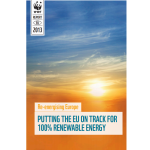 According to a brand new study carried out by consultancy Ecofys and commissioned by the WWF, the European Union can halve its greenhouse gas emissions by 2030.
According to a brand new study carried out by consultancy Ecofys and commissioned by the WWF, the European Union can halve its greenhouse gas emissions by 2030.
We have seen time and again that the European Union has been a leader in the fight against climate change when it unveiled its now famous 20-20-20 by 20 strategy. We also have seen that the EU could go further and that 30 percent cuts are achievable by 2020 as its Emissions keep decreasing.
What the EU currently lacks is a vision for 2020 and a plan for further cuts afterwards. There is indeed nothing official on the much needed energy transition to be done at a European level.
Now the WWF and Ecofys demonstrates that – with the right incentives and policies – by 2030 the 27 members of the EU could get 40 percent of its energy from renewables and cut their energy use by 38 percent (compared to a business as usual projection).
The report is a reminder that achieving 100 percent renewables across the economy by 2050 is absolutely feasible.
By 2030, Ecofys projects that 65 percent of the Union’s electricity, 35 percent of its heat and 29 percent of its fuels could be powered by renewables.
Energy efficiency, as you can imagine, would play an important role in this endeavor. Here is an overview of what could be done.
Ecofys breaks European energy savings by economic sector, with industry consuming 31% less energy, buildings making a 26% saving, and transport energy consumption falling by 11%, all by 2030.
The methods involved in the reductions would change from sector to sector. Transport emissions would be cut by fuel economy measures, improved air traffic management, and greater vehicle electrification and use of hybrids.
In industry, a 60 to 70 percent reduction in the intensity levels on 2000 levels would be achieved through increased recycling, stringent and ongoing ‘best available technology’ guidelines and ambitious plant refurbishments.
By contrast, with buildings, a 2.5 percent annual retrofit is proposed, along with increased heat recovery, insulation and ventilation systems, heat pumps, solar thermal systems and local renewable solutions where possible.
Let’s hope the European Union will take advantage of this report and many others to provide an ambitious energy and climate project for 2030 and beyond.